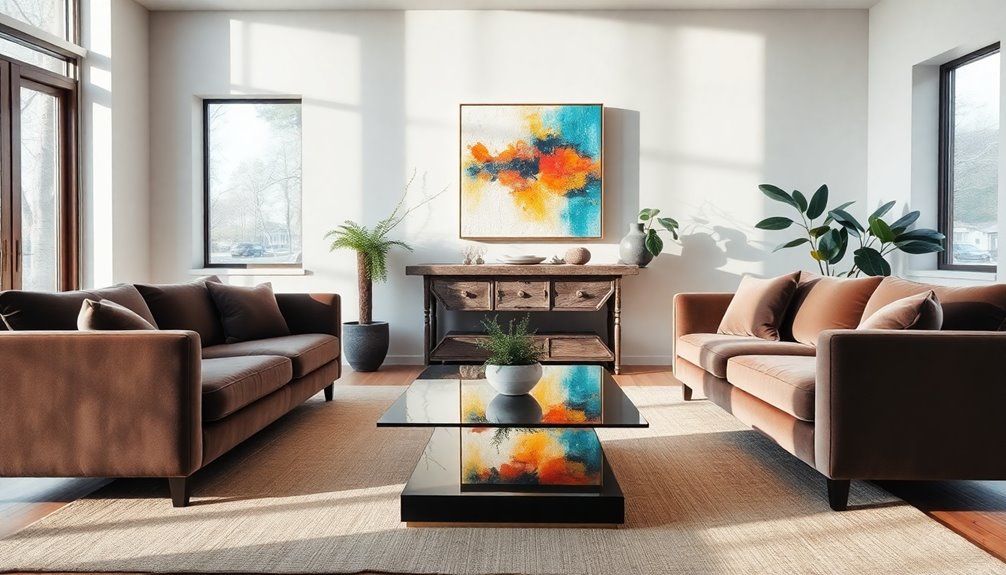To balance symmetry and asymmetry in your home decor, mix matching furniture pieces with varied accessories. Use symmetrical elements, like identical lamps, to create structure, then add asymmetrical accents, such as an eclectic gallery wall. Incorporate bold focal points and contrasting textures to enhance depth. Arrange items in odd numbers for a relaxed vibe while ensuring a cohesive color palette. Explore further techniques to achieve visual harmony and transform your space into a enchanting retreat.
Key Takeaways
- Combine matching furniture pairs with varied decor elements to create a balanced look of symmetry and asymmetry.
- Use odd-numbered groupings for artwork or decor to introduce natural asymmetry while maintaining visual interest.
- Integrate contrasting shapes and textures to add depth and unify both symmetrical and asymmetrical elements in the space.
- Position focal points strategically to encourage appreciation from multiple angles, enhancing visual intrigue and balance.
- Employ smart lighting to highlight decor elements and ensure visual equilibrium through thoughtful placement and negative space.
Understanding Symmetry in Home Decor
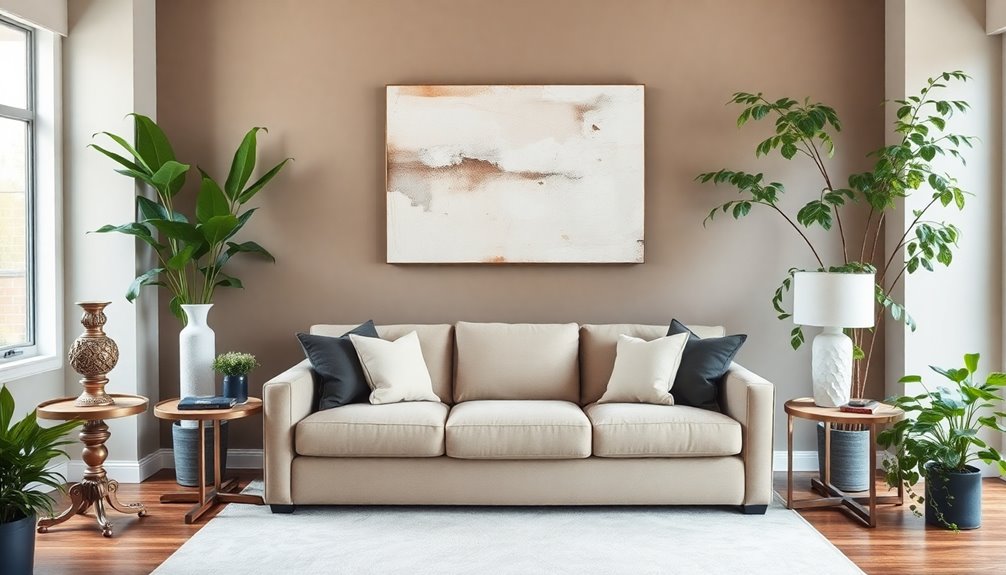
Have you ever noticed how symmetry can transform a room? When you arrange your interior elements with symmetry, you create a mirror-like balance that brings order to your space.
Think about matching furniture, like identical chairs flanking a fireplace or bedside tables with lamps on either side of your bed. This arrangement not only enhances visual appeal but also evokes a sense of stability and tranquility.
Symmetrical designs are often found in traditional styles, yet they can also fit beautifully into contemporary decor. By thoughtfully incorporating symmetrical elements, you can achieve a harmonious atmosphere that’s pleasing to the eye. Additionally, using natural materials can enhance both symmetry and warmth in your decor.
The Role of Asymmetry in Design
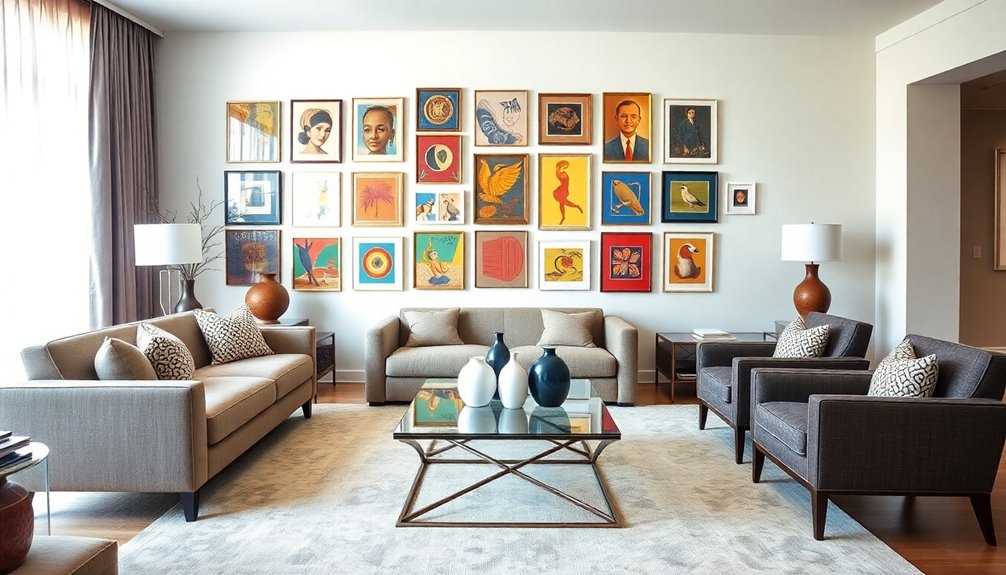
Asymmetry plays an essential role in creating visual interest and engagement in your home decor. By mixing varied elements and using techniques like odd groupings, you can achieve a relaxed, modern aesthetic that feels inviting. This approach is particularly beneficial for creating cozy spaces, which serve as comfortable retreats for families and seniors. Let’s explore how to effectively implement asymmetry to enhance your space.
Visual Interest and Engagement
While many people gravitate towards symmetrical designs for their perceived order, embracing asymmetry can markedly elevate the visual interest and engagement in your home decor.
Asymmetry introduces movement and energy, creating a dynamic atmosphere that invites exploration. By arranging decor items in an uneven manner—like an oversized artwork on one wall balanced by smaller pieces—you foster a balanced space that encourages interaction.
Utilizing odd-numbered groupings, such as three accent chairs, enhances visual appeal and stimulates curiosity. Combine contrasting textures and colors to achieve asymmetrical balance while maintaining visual harmony. This approach not only breaks the rigidity of traditional designs but also creates an engaging design that feels relaxed and inviting, showcasing your individuality in home decor.
Incorporating natural materials can further enhance the balance of asymmetrical decor, adding depth and warmth to your space.
Informal and Modern Aesthetics
Embracing asymmetry in your home decor naturally introduces a sense of informality and modernity, making spaces feel more inviting.
As you explore asymmetry in interior design, you’ll find that it fosters visual intrigue and creates a sense of liveliness. By incorporating varied furniture styles and textures, you can achieve balanced and harmonious arrangements that reflect your personal expression.
Asymmetrical balance relies on visual weight, allowing you to mix different sizes and colors for a casual aesthetic. It’s essential to recognize that contemporary or modern styles, like mid-century modern, leverage these principles to evoke movement and energy.
Utilizing odd numbers of items in decor arrangements can also enhance visual balance, leading to engaging and dynamic layouts. Additionally, incorporating high-quality pigments in your decor elements can further elevate the overall aesthetic of your space.
Techniques for Asymmetrical Balance
Achieving a harmonious yet dynamic space requires an understanding of how to effectively balance different visual weights.
To master asymmetrical balance, consider these techniques:
- Use varying furniture shapes and sizes, like large sofas paired with smaller accent chairs, to distribute visual weights.
- Incorporate odd numbers in decor arrangements, grouping items in threes or fives for natural flow.
- Vary heights in your decor, such as tall floor lamps alongside shorter tables, to create depth and tension.
- Utilize strategic placement and embrace negative space, ensuring visual equilibrium and preventing overcrowding.
- Additionally, consider integrating smart lighting that can enhance the overall atmosphere and highlight key decor elements for a more dynamic look.
Establishing a Focal Point
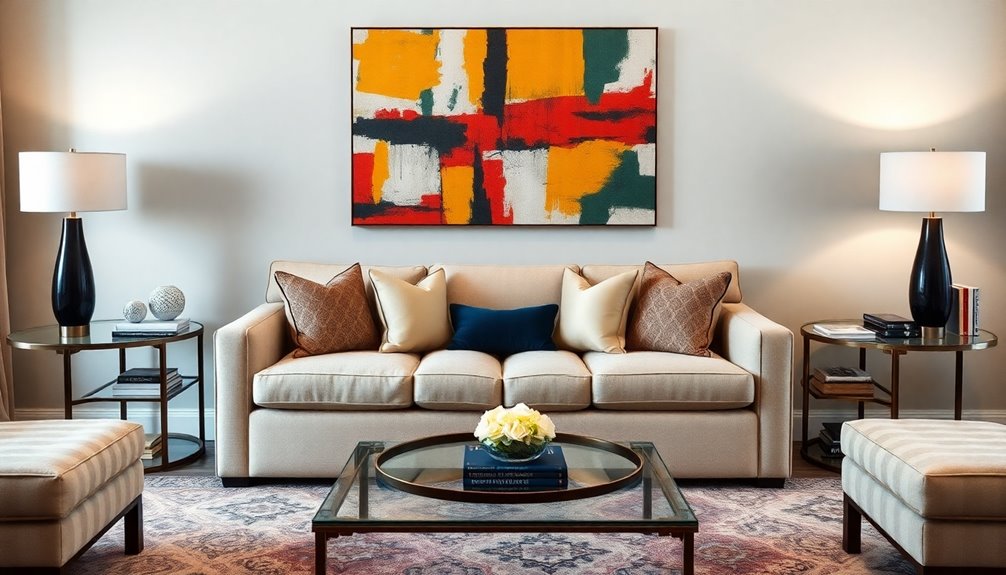
A focal point is essential in any room, acting as the visual anchor that draws the eye and enhances the overall design.
By establishing a strong central area of interest, you create a balanced design amidst both symmetrical elements and asymmetrical arrangements.
Choose a bold piece of artwork or a striking piece of furniture that adds contrast, making your space feel dynamic and engaging.
Position your focal point to be appreciated from multiple angles, ensuring it contributes to the visual flow.
Surround it with varied heights and shapes to add visual intrigue while maintaining a cohesive design theme.
This thoughtful arrangement enhances the room’s visual appeal, making it inviting and harmonious. Additionally, consider incorporating natural materials to enhance the overall farmhouse aesthetic.
Incorporating Symmetrical Elements

When you’re looking to incorporate symmetrical elements into your decor, think about pairing identical furniture pieces like chairs or tables for a cohesive look. Balanced wall art, such as a central piece with matching sconces, can enhance the visual appeal of your space. Don’t forget about lighting fixtures; placing identical lamps on either side of a sofa can create a warm and inviting atmosphere. Additionally, incorporating innovative interior design ideas can further enhance the harmony and balance of your decor.
Identical Furniture Pairing
Two matching armchairs or bedside tables can transform your space by introducing a striking sense of symmetry. Identical furniture pairing creates visual stability, enhancing the overall balance of your room.
Position these pieces equidistant from a central focal point, like a fireplace or bed, to maintain balance and enhance aesthetic appeal. This approach not only adds elegance but also simplifies visual navigation.
Consider these tips for successful identical furniture pairing:
- Choose pieces that complement existing design features
- Confirm the scale and proportion fit the space
- Aim for a cohesive look that feels inviting
- Play with textures to add depth while preserving symmetry
Incorporating natural materials in your furniture selection can further enhance the rustic charm characteristic of modern farmhouse decor.
Balanced Wall Art
Creating a balanced wall art arrangement not only enhances the visual appeal of your space but also establishes a sense of harmony throughout the room.
To achieve this, consider incorporating symmetrical elements. Start with a large statement piece at the center, flanked by smaller, matching pieces on either side. This creates a focal point that draws the eye.
You can also arrange a gallery wall in a grid pattern, ensuring equal spacing between the artwork for a cohesive look. Adding identical wall sconces next to your art can further enhance the balanced decor while providing consistent lighting.
Finally, maintain symmetry by ensuring color and shape consistency in your wall art to create a unified aesthetic throughout your space. A distinctive decor style can further enhance the overall aesthetic appeal of your home.
Symmetrical Lighting Fixtures
To achieve a harmonious atmosphere in your home, incorporating symmetrical lighting fixtures can make a significant impact.
These fixtures enhance visual appeal and foster a calming atmosphere by balancing symmetry in your decor. Consider these ideas:
- Use matching pendant lights or wall sconces to create cohesion in a space.
- Place identical table lamps on either side of a sofa or bed for order and elegance.
- Install a central chandelier, complemented by symmetrical wall sconces, to highlight architectural features.
- Pair sconces with a fireplace or artwork to guarantee these elements are well-lit.
Additionally, incorporating natural elements into your lighting choices can further enhance the tranquil ambiance of the room.
Adding Asymmetrical Accents
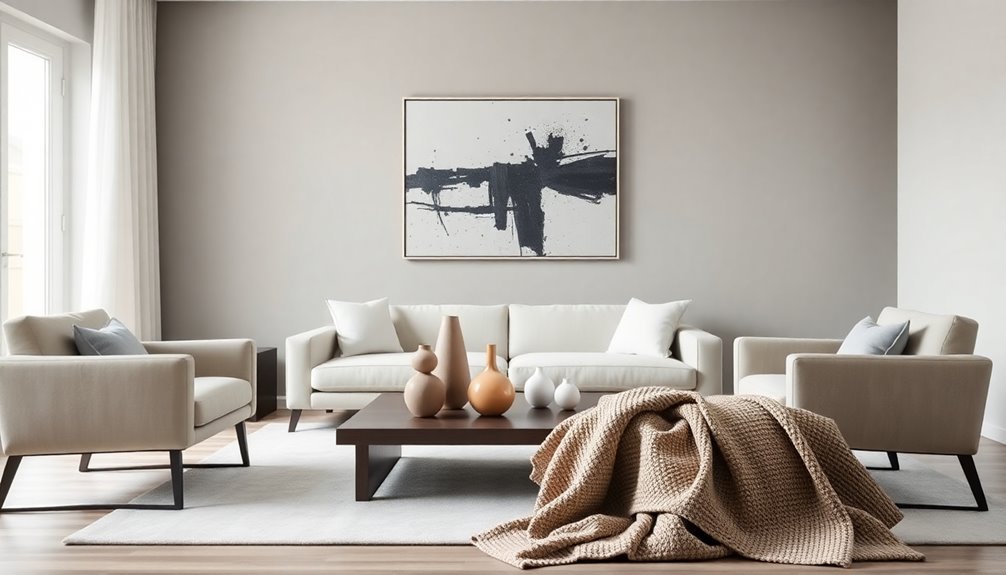
Asymmetry can breathe new life into your home decor, making spaces feel dynamic and engaging.
Start by introducing varying heights in your decor, like a tall floor lamp paired with a low-profile coffee table, to create visual tension. Incorporate an odd number of decorative objects—three sculptural vases of different sizes—enhancing natural asymmetry and drawing the eye.
Mismatched seating options, such as a modern chair next to a vintage loveseat, add character while keeping a cohesive color palette.
Arrange wall art in an asymmetrical layout, combining pieces of different sizes for a dynamic gallery wall.
Finally, experiment with contrast materials, like a sleek metal table alongside a rustic wood sideboard, achieving asymmetrical balance in interior design and avoiding visual monotony.
Techniques for Achieving Balance
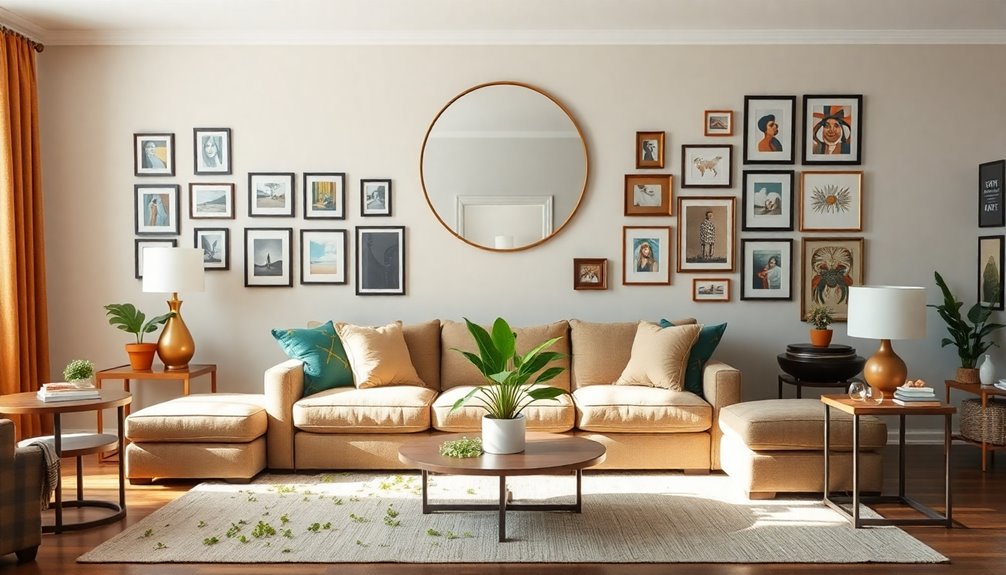
Balancing design elements is key to achieving a harmonious look in your home.
To create balance in interior design, you can mix symmetrical design with asymmetry. Here are some techniques to enhance visual appeal:
- Use matching furniture pieces, like pairs of chairs, alongside varied decor elements.
- Incorporate bold accent pieces, such as a large artwork, to draw attention.
- Experiment with varying heights and shapes when arranging objects, like tall vases or stacked books.
- Group decor items in odd numbers, typically threes or fives, for a natural asymmetry.
Creating Visual Interest With Contrast
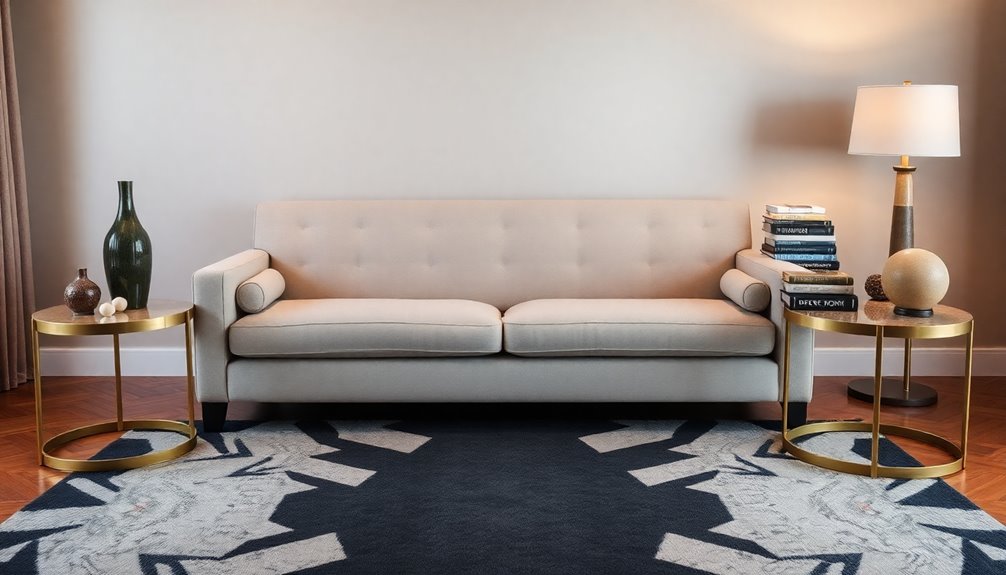
Creating visual interest in your home starts with embracing contrast. By incorporating contrasting shapes and sizes in your furniture, like a large angular sofa paired with rounded accent chairs, you enhance the overall design.
Mixing textures, such as smooth and rough finishes, adds depth and keeps your space dynamic. When displaying decor, group pieces in odd numbers—three or five—creating engaging arrangements that maintain visual balance through contrast.
Stick to a cohesive color palette while introducing contrasting hues; pairing neutral tones with vibrant accents highlights focal points without overwhelming the room.
Finally, strategically place decor items at varying heights, as this adds visual tension and intrigue, breaking monotony and encouraging exploration throughout your space.
Tips for Maintaining Harmony in Your Space

To maintain harmony in your space, think about how your furniture and decor can work together. Start by utilizing matching furniture pairs, like identical armchairs, to establish symmetry while adding varied decor for intrigue.
Achieve harmony by pairing matching furniture while incorporating diverse decor for a captivating balance.
Focus on these tips:
- Create an asymmetrical gallery wall with an odd number of pieces for balance.
- Use a cohesive color palette to unify both symmetrical and asymmetrical elements.
- Balance visual weight by placing heavier items, such as a large sofa, opposite lighter accessories.
- Introduce contrasting shapes and textures, like rounded cushions on a rectangular sofa, to enhance depth.
Frequently Asked Questions
How to Create Asymmetrical Balance in Interior Design?
To create asymmetrical balance in your interior design, start by grouping objects in odd numbers, like three or five, to attract the eye.
Use furniture and decor of varying heights and scales for dynamic contrasts.
Introduce a bold focal point, like a large artwork, to anchor the space.
Mix different textures and colors to create visual weight, and position larger items on one side with smaller ones on the opposite to maintain harmony.
How to Balance Asymmetrical Design?
To balance asymmetrical design, focus on using odd numbers in your arrangements—three or five pieces can create visual interest.
Pay attention to visual weight; pair larger, darker items with smaller, lighter ones.
Vary heights and shapes to enhance your decor’s dynamic quality.
Don’t forget about negative space; leaving empty areas gives your design room to breathe.
Finally, trust your instincts—your personal touch can make your space feel uniquely balanced and visually appealing.
Can Designs Be Balanced Symmetrically or Asymmetrically?
Designs can be a dance between order and chaos, where each element plays its part.
You can achieve balance symmetrically by placing similar items around a central point, creating harmony and structure.
On the flip side, asymmetry allows for a playful arrangement of diverse pieces, giving your space life and movement.
Both styles harmonize beautifully, drawing the eye and fostering a sense of balance that feels both inviting and intriguing.
What Is the Law of Symmetry in Interior Design?
The law of symmetry in interior design helps you create a sense of order and stability.
By positioning identical or similar objects around a central point, you enhance visual cohesion and elegance. Think matching side tables or chairs flanking a focal point.
This approach not only simplifies your design choices but also promotes a calming atmosphere.
Conclusion
In the world of home decor, balance is key—after all, “too much of a good thing can be wonderful.” By blending symmetry and asymmetry, you can create a space that feels both harmonious and dynamic. Remember to establish a focal point, incorporate both symmetrical elements and asymmetrical accents, and use contrast to add visual interest. With these tips, you’ll maintain a sense of balance that makes your home a true reflection of your style.
